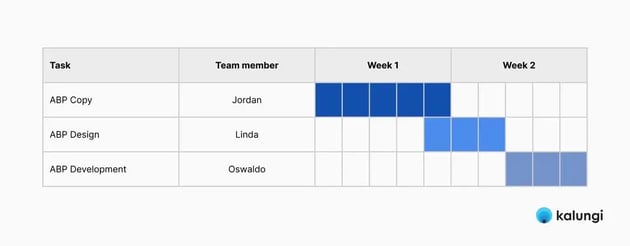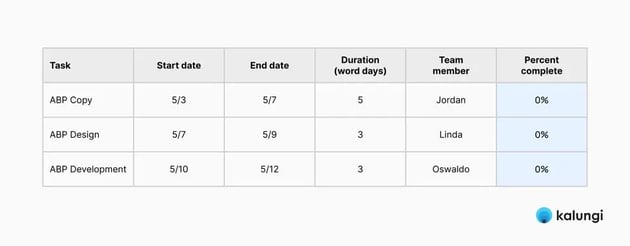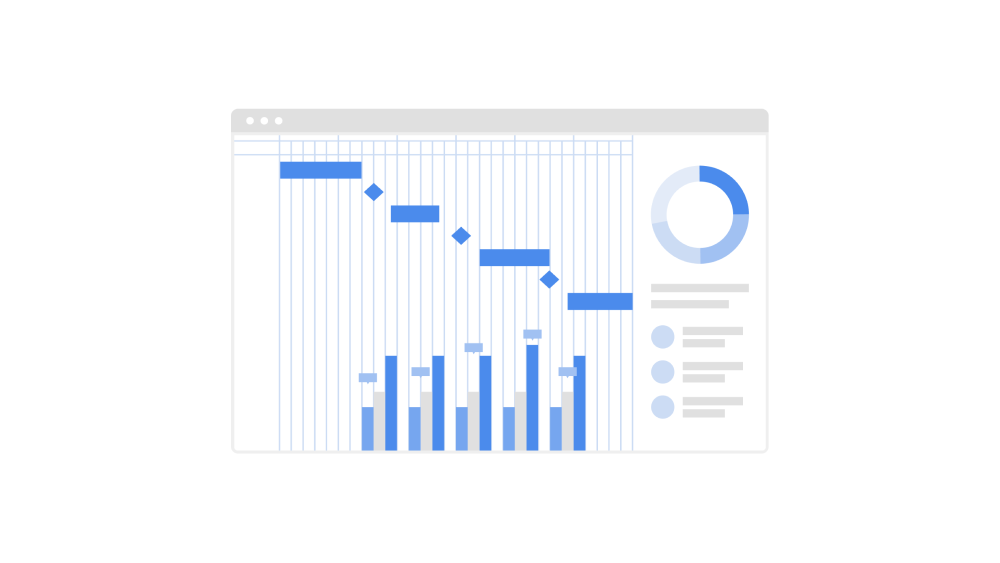One of the biggest challenges when starting any SaaS marketing campaign is making sure that team members are aligned and clearly understand the project objectives. Using a Gantt chart for your marketing plan can be a great way to neatly organize essential tasks, stay focused on your timeline, and keep your team accountable.
A project can be anything from running a 2-week holiday social media campaign to a complete rebranding campaign, so it's important to arm yourself with the tools to identify granular tasks and components that come together to form a campaign.
When the whole team is engaged and understands the reasoning behind the tasks they are assigned, it allows for thoughtful execution and meaningful collaboration.
Why use Gantt charts for your SaaS marketing calendar
Gantt charts are a visual representation of both a project's process and the relationship between your team and their individual tasks.

Making a Gantt chart is a great way to help you and your team stay organized because it allows everyone to not just see their own assignments but also how tasks are interdependent. It also is a powerful reminder to team members that their contribution is not just an isolated task but is invaluable to the entire project. In other words, think of Gantt charts as the "how" that holds together the "who, what, when, where, and why" of your project.
There are many applications and products out there that provide project management capabilities using Gantt charts. However, our team at Kalungi has found that a trusty manual Gantt chart is the perfect place to start and is often more than enough for planning out your projects and visualizing them at a glance.
How to structure your Gantt chart
Organize your Gantt chart by phases, tasks, or components with the earliest ones at the top and the latest ones at the bottom. Although this is the best practice for clear visualization, you do not need to go crazy with making sure that every row starts before the next row. Sometimes there are one-off tasks that do not need to wait for a previous task to finish before it can be started and some can be done in conjunction.
Time intervals can be days or weeks or even months depending on the scope and scale of your project. Make it your own!
Team transparency
A useful purpose of the Gantt chart is to show which team member is taking ownership of which task. This helps the CMO or project manager know who to go to if they have any questions or updates. It is also useful for members who are responsible for interdependent tasks to quickly identify and collaborate with other team members.

Our Gantt chart also has a progress column which, if you use Google Sheets, allows everyone to update the progress of their task. Then, you can easily see at a glance if they are on track. Our team likes to conduct weekly syncs using the Gantt chart to communicate progress and address any blockers. Take this opportunity both to hold people accountable for their tasks and ask what the rest of the team can do to help them if they are behind.
Reporting on progress
Any SaaS marketing campaign will need periodic reviews and reporting to make sure that the project is not veering off track. Reporting on SaaS marketing is an art in and of itself, and making good use of Gantt charts as an organizational tool may prove invaluable when it comes time to report. The visual nature of the chart allows your readers to easily see the progress and scope of your project.
Jumpstarting your SaaS marketing calendar
Many of us have found ourselves in a situation before where we have a brilliant idea but we are not quite sure how to bring it to life. This is no different with SaaS marketing—sometimes we know exactly what a campaign should be when it should start and how long it should take, and even why we are implementing it, but we don’t always know how to approach it.
With the assistance of a Gantt chart, you and your team will have a better understanding of each team member’s role and benefit from the added clarity and transparency in any SaaS marketing campaign.
